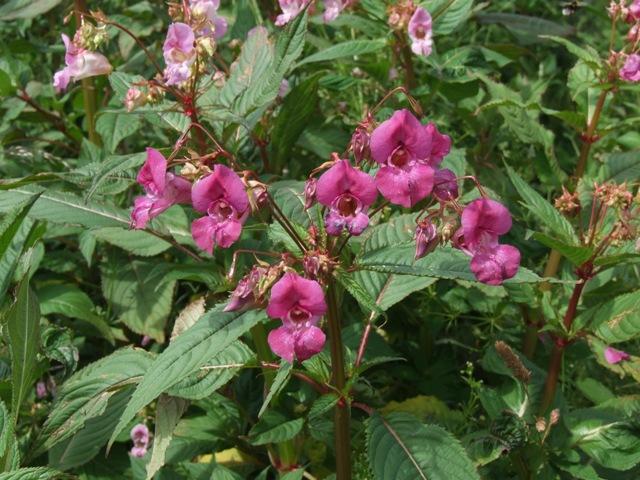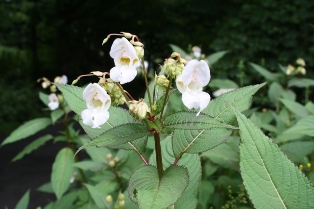
Himalayan balsam in flower.
Until the last few years, the River Ayr catchment was the only system in Ayrshire free from Himalayan balsam. In 2013 Ayrshire Rivers Trust found 5 plants and pulled them in Ayr opposite the college. In 2014 ART found a single plant at Barskimming Bridge and it was pulled. Again last year ART found this invasive plant on the Lugar in increasing quantity and pulled it the vicinity of Dumfries House and downstream to Auchinleck House estate water.
It is clear that there is a low density population that will quickly rampage out of control unless it is effectively dealt with and the board have to rely on both anglers and landowners to take the time to pull any plants they see. In fact we need everyone to actively seek this plant out before it takes over.

The flowers range from deep pink through to almost white.
Himalayan Balsam is an annual plant that reproduces from seed. As the seed pods ripen, they explode spreading the seeds for up to 7 meters. A single plant can produce as many as 2000 seeds each year and they remain viable for around 2 years so although invasive, this plant can be eradicated by effective control sustained for a couple of years. Himalayan balsam is a problem because it excludes other native species. In winter the plant dies back leaving river banks bare and prone to erosion. Soil enters the water increasing siltation and bound to soil particles are nutrients that lead to enrichment and reduced water quality eutrophication and oxygen levels. This plant is a huge threat to fish population for the above reasons.
Pulling and uprooting plants is the method that anglers and landowners can easily use on the Lugar and Ayr to achieve eradication before the plant takes hold. More details of control methods are listed below.
Recommended methods of control.
- Spraying using knapsack sprayer and systemic, glyphosate based herbicide. Roundup Pro Biactive is widely accepted as the most effective chemical suitable for use near watercourses. The main disadvantage to using herbicides to control any invasive weed is the unavoidable application to native plants growing in the immediate vicinity of the target species. Consequently, spraying is only recommended where HB forms large dense stands and prior to flowering.
- Strimming and mowing of HB is effective but only prior to the seed pods developing. Any attempt to cut this plant once the seeds have developed will cause the seed pods to burst, spreading the plant. Strimming can be performed from spring to around early July.
- Manual pulling. This is a slow technique only really suitable for low density infestations. Pulling should be performed prior to the formation of seed pods. The plant should be uprooted if possible as this ensures that new shoots can’t develop. This method is highly suited to dealing with initial outbreaks of the species.
As HB is an annual and its seed viability is thought to be around two years, it can be eradicated in a relatively short period of time with sufficient effort. Strategic control from the upstream limit would be required to achieve this goal.
Due to reduced angling effort and membership of clubs, the Ayr board doesn’t have the ability to raise levies to provide adequate financial resources to allow contractors to be appointed to deal with this plant so in reality, unless anglers and owners quickly get on top of this plant, it will quickly explode out of control and become impossible to eradicate.
Details of the plant and control methods provided by Ayrshire Rivers Trust. Copyright of images remains Ayrshire Rivers Trust’s and they should not be reproduced without their permission.

